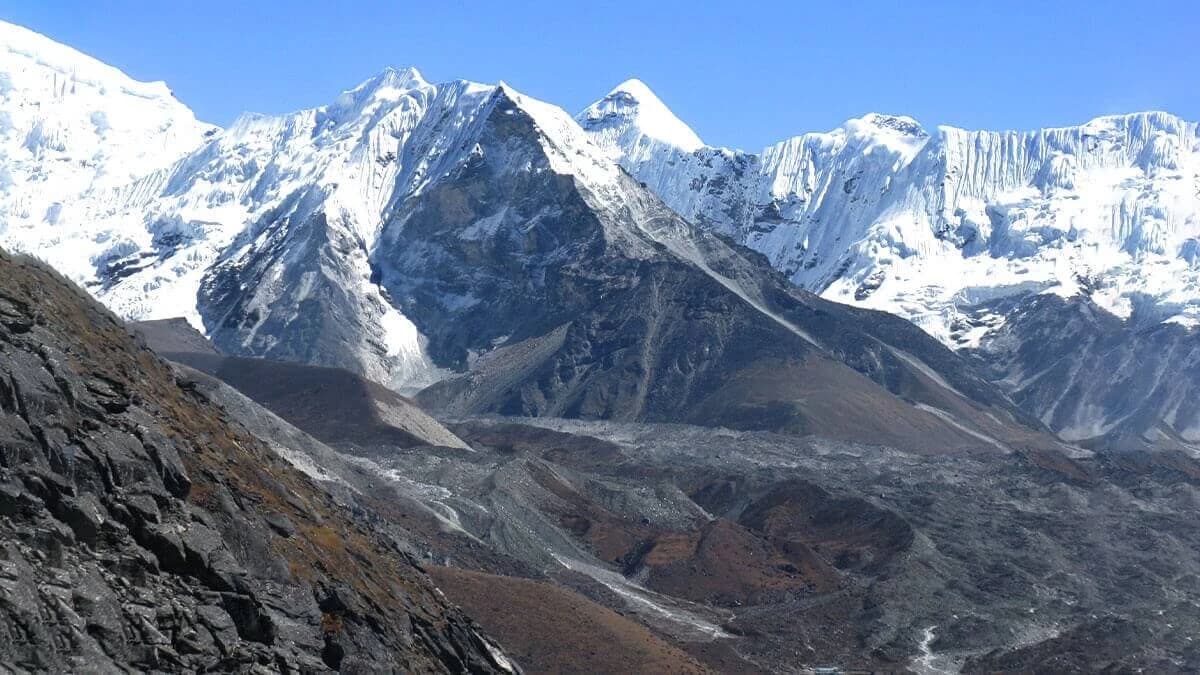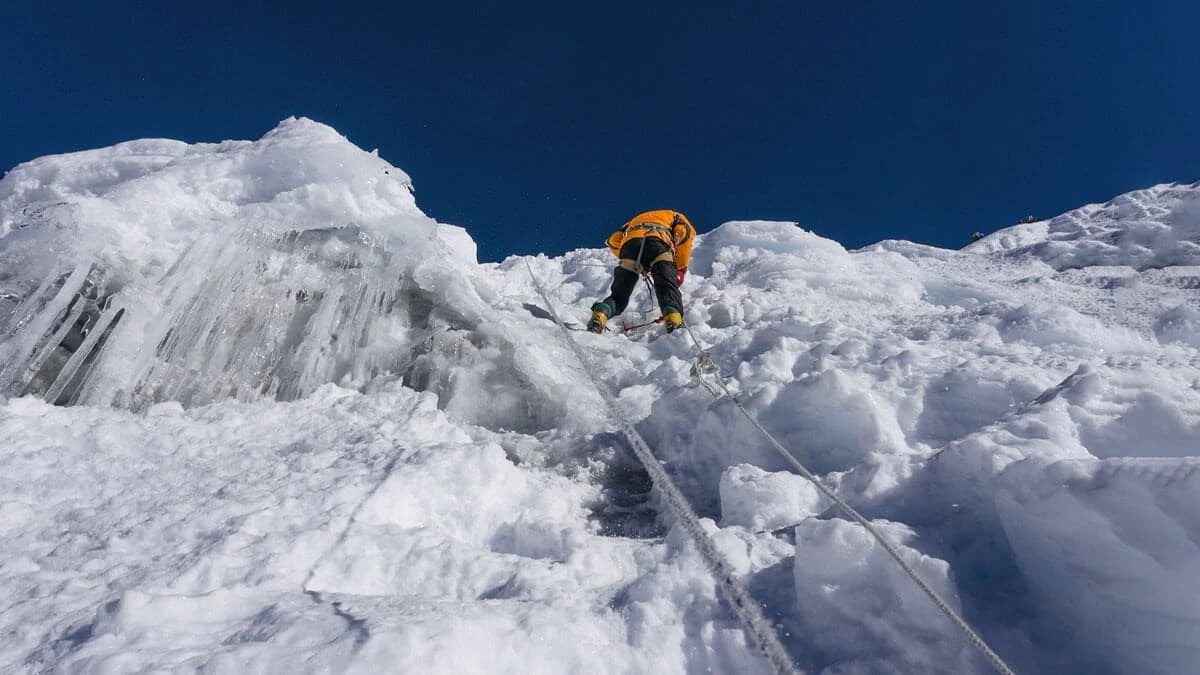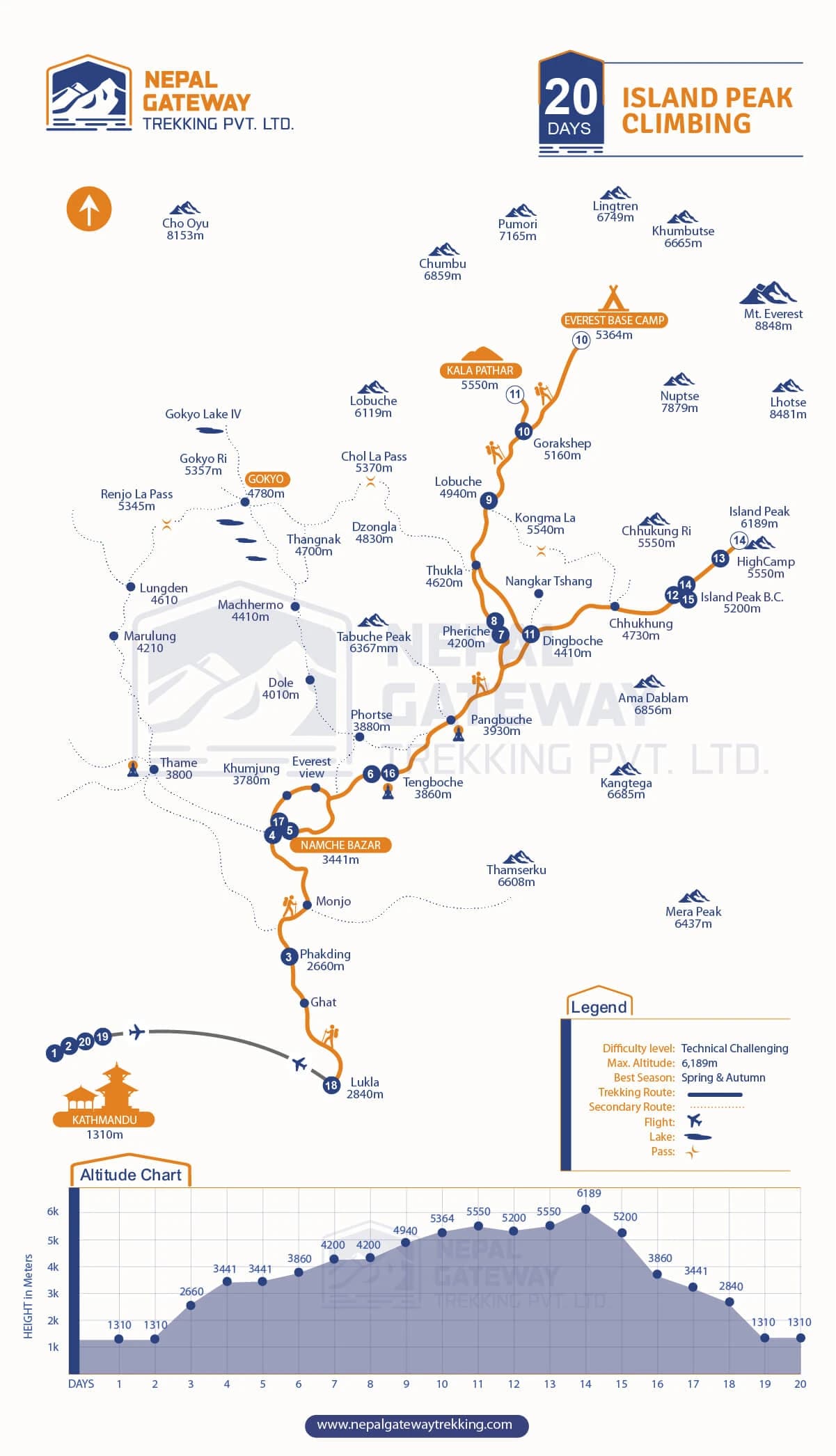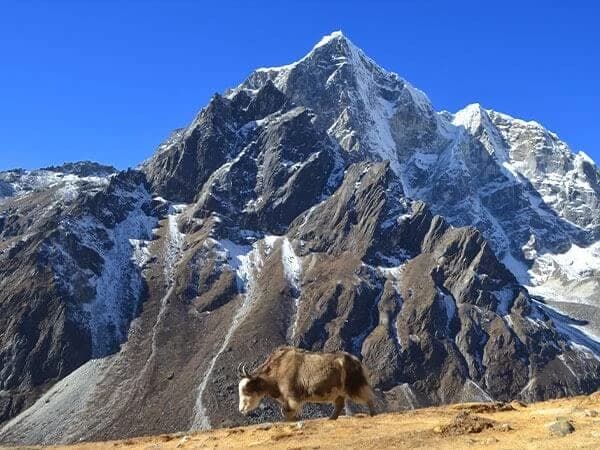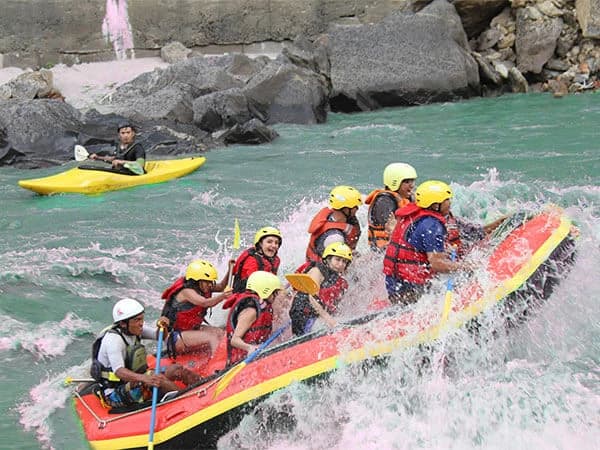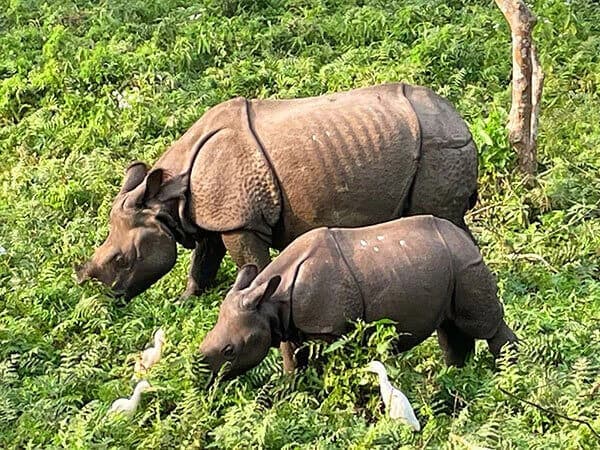Attempt your first peak-climbing expedition in the Himalayas by joining our adventurous yet doable Island Peak Climbing with Everest Base Camp Trek. Go beyond trekking and taste the adrenaline of mountain climbing.
Island Peak Climbing
Island Peak Climbing in Nepal is a well-known trekking and climbing activity for beginners and mountain lovers. Island Peak is a trekking peak. The trail is not technically advanced and is perfect for beginner climbers. In this package, we have extended our Everest Base Camp Trek and combined the Island Peak Expedition in the journey. Before pushing towards the top of this peak, we ascend to the Everest Base Camp and Kala Patthar, which is also ideal for acclimatization.
During Island Peak Climbing with the EBC Trek, you reach the lap of Mt. Everest base camp and summit a peak. Island Peak is known as Imja Tse in Nepali, so do not get confused if we use this term anywhere on the page.
The first part of the EBC Trek with Island Peak passes through a Sherpa village and lush forests. You traverse a high altitude above the tree line along gorges, moraines, and glacial paths. You will experience the heartwarming welcome of the locals and visit ancient monasteries on your way to Mount Everest Base Camp.
While trekking in the Himalayas can pump you up with adrenaline, the enriching cultural experience will keep you grounded and remind you to breathe and unwind your worries.
Important Note: During the peak season, flights will be operated from Manthali Airport, Ramechhap, to Lukla. In the spring, from mid-March to mid-May and late September to November in autumn, all flights take off and land at Manthali Airport.
The Manthali airport, Ramechhap, is 142 km from Kathmandu, a 4-5 hour drive. To catch a flight to Lukla from Ramechhap, you must depart from Kathmandu from 1 a.m. to 2 a.m.
We highly recommend that you come with at least one more extra day for jet lag, especially considering the early morning drive to Manthali Airport, which benefits from adequate rest and sleep beforehand.
The significant highlights of Island Peak Climbing
- Climb 6,000 meters above a peak in the Everest region.
- Trek to Everest Base Camp and Kala Patthar.
- Witness the lifestyle of Sherpas and their tradition.
- Walk through dense forests and beautiful mountain villages before going above the treeline.
- Visit old monasteries along the way and get to live a Himalayan lifestyle.
- Climb with reliable and the best Sherpa guides.
- Full support during the climbing period with basic climbing training.
About Island Peak
Situated in the Chukkung Valley, Island Peak is one of the most stunning peaks in the Himalayas. It is dominated by the giant Lhotse and Nuptse south walls in the north and Baruntse to the south.
The island peak is the extension of Lhotse Shar's south ridge. It is separated by a col ridge rising to the south from this point, which leads to the summit of Island Peak.
Edmund Hillary and Sherpa Tenzing discovered the island peak in 1953 during their expedition to Mt. Everest. They have used it as a training peak. To this date, mountaineers use the island peak as a training peak before approaching eight thousand meters above the mountains.
Views during the Island Peak Climbing with the EBC Trek route
Island Peak Climbing with the EBC Trek Route offers fantastic mountain panoramas. You witness diverse landscapes from different viewpoints, like the Everest View Hotel and Kala Patthar. Kala Patthar especially offers a gorgeous sunrise with 360-degree views of the snow-capped peaks.
While trekking and climbing, you can see mountains like Everest, Lhotse, Makalu, Nuptse, Cho Oyu, Kanchenjunga, Ama Dablam, Thamserku, and Baruntse. Likewise, the views of glaciers, waterfalls, and lush valleys are excellent.
How difficult is the EBC Trek with Island Peak Climbing?
The overall EBC Trek with Island Peak Climbing is a challenging journey. It involves strenuous climbing, steep, rugged terrain, high altitude, sun exposure, and cold exposure. Island Peak Climbing is for experienced trekkers and climbers who want to introduce themselves to slightly technical climbing in the Himalayas.
Following the Chukkung Valley, we reach the base camp of Island Peak. From here, the summit walk is around a 9-12 hour round trip. The route to the summit is rocky and steep. You walk along the snowline using fixed ropes. Before reaching the summit, you cross crevasses and 300 meters of the headwall.
Preparation for Trek to EBC and Island Peak Climb
To prepare for the Island Peak climb, do daily exercise that involves training your muscles' endurance and stamina. Go on short hikes and treks with long walking hours with a daypack weighing around 5 kg. If possible, try hiking on similar terrain (steep and rugged).
Prepare your gear early and break in your new trekking or climbing boots. Our team will provide a packing list to help you prepare your gear.
Booking Open for EBC Trek with Island Peak Climbing Package 2025
We have opened a booking for the EBC Trek with Island Peak Climbing Package 2025.
Join our Island Peak Climbing with EBC Trek 2025 for the most adventurous journey of your life. We have the best climbing crew, led by the industry's most experienced Sherpa guides, who will assist you in reaching the summit.
Click on our "Book This Trip" button on the package page. This will lead you to the simple booking process, which takes a few minutes. Once we receive your booking request for Island Peak Climbing with Everest Base Camp Trek, our team members will contact you and help you with further procedures.
Itinerary
This is our standard and recommended itinerary for Island Peak Climbing with Everest Base Camp Trek.
You meet our airport representative at the Tribhuvan International Airport in Kathmandu on your arrival day. He will help load your luggage and take you to the designated hotel. You can take your time to unpack and relax.
In the evening, you join a group meeting organized by the company with other team members.
Today, we get a climbing permit from NMA for climbing Island Peak and introduce you to your team leader/climbing guide. There will be a small briefing session; check the equipment and prepare for the journey.
Your trekking guide will meet you at the hotel lobby to drive to Kathmandu airport for a short flight to the Lukla airstrip. It is a lifetime flight experience for you. The flight is very scenic. You can see the villages and forests from the plain window.
At Lukla, our porters join you for the journey. We load all the leagues and begin descending towards Phakding village. The views of Kusum Kangaru and Kongde Ri from this village are stunning
Today's trail ascends to the Sherpa town of Namche Bazaar. From Phakding, you walk on forested paths to Monjo village, passing other villages, such as Tok Tok and Banker. In Manjo, we register your trekking permits at Sagarmath National Park's office.
You trek through dense forests, crossing suspension bridges numerous times, and waterfalls to reach Jorsalle. You have your lunch at Jorsalle before steeply ascending to Namche Bazaar. A glimpse of Mount Everest is offered while ascending.
Today, you spend your day exploring and resting in Namche Bazaar. You then do an acclimatization hike to the Hotel Everest View. This luxurious hotel offers breathtaking views of mountains like Everest, Lhotse, Ama Dablam, Nuptse, Tawache, etc.
From Namche Bazaar, the trail goes almost flat to Sanasa village, with spectacular views of Mount Everest, Lhotse, and Ama Dablam. Then, you descend to Phungki Thanka for lunch. After lunch, you cross the Dudh Koshi River by suspension bridge and ascend to Tengboche village through lush forests of rhododendrons.
Tengoche is on a hilltop with the famous Tengboche Monastery, one of the biggest monasteries in the Khumbu region. The village offers incredible mountain views with sunrise and sunset.
You descend through deep rhododendron forests. You pass a nunnery and long mani walls and cross the Imja River before reaching Pangboche Village, which offers a tremendous view of Mount Ama Dablam.
The trail ascends through farming areas and remote villages to Somare for a lunch break. You come across yak herders and alpine meadows to reach Pheriche village.
Today is the second acclimatization day of the trip. You will hike to a nearby hill and explore the village. These acclimatization days are crucial before the summit to avoid altitude sickness.
From Pheriche, the trail gets rugged and steep. You leave the tree line behind and walk in a dry, barren area. Mountains like Lhotse, Nuptse, Pumori, etc, are seen along the way. The climate begins to get colder and more exposed to the sun.
Our last stop is Everest base camp before returning to Gorak Shep to spend the night. From Lobuche, you walk on a flat moraine to the bottom of Lobuche Pass. It is a short, steep climb to reach the ridge, then the trail, and passing by the lateral moraine of the Khumbu Glacier.
The trail passes by Gorak Shep and leads to EBC, which has several uphills and downhills. The thin air makes this part of the trek more exhausting than it is.
After reaching Everest Base Camp, you will be congratulated on your significant achievement. You take photos and videos before returning to Gorak Shep.
You hike to Kala Pathar early in the morning. The top offers a gorgeous sunrise with 360-degree views of the Himalayan mountains. The views from Kala Patthar are unbelievable.
Then you go back to Gorak Shep for a hot breakfast and descend to Dingboche to spend the night. It's a long, downhill walk.
Today, you join the more exciting part of the trip, the Island Peak climbing. From Dingboche, you gradually make your way through Moraines to Pareshaya Gyab. Mt. Ama Dablam dominates the sky with its giant presence. You reach Chhukung and have lunch before you ascend towards the base camp of Island Peak (6,189 m).
The team leader will give you pre-climbing training that will boost your confidence at Island Peak Base Camp.
After a hot breakfast at the Island Peak Base Camp, you ascend to the Island Peak High Camp. The views along the way are phenomenal. It's a short walk up to the High Camp, so you'll have time to rest.
You wake up before the light breaks for the final push and follow a steep uphill scree. The route then passes a narrow gully and scrambles over the rock to reach the crampon point at the edge of a glacier. From here onwards, you use climbing gear and cross a few deep crevasses using ladders and fixed ropes.
Further crossing the summit ice wall, you reach the top of Island Peak. After spending some time at the top, you descend back to Chhukung via Island Peak base camp to spend the night. Before leaving the base camp, you clean it and take all of your waste down to a lower elevation for proper decomposition.
It's an extra day if you have to take a break between the climbing period because of bad weather or other unseen circumstances. You'll have an extra day in Kathmandu to spend if not used.
From Chhukung, the trail passes through beautiful villages like Dingboche, Pangboche, and Debuche. Today, you walk back on the same trail to Tengboche. You walk through alpine meadows, reach treelines, and ascend through rhododendron forests.
After breakfast, you begin trekking down to Punki Thagna through lush forests and small villages. The trail ascends to Kenjuma village, where it joins a flat path to reach Namche Bazaar.
After taking a short flight, you reach Kathmandu. The flight offers long views of the snow-clustered mountains.
Our airport team will escort you to the international airport. They will pick you up from your hotel lobby and drop you off at the airport's terminal gate.
Dates & Availability
Private tripCost Includes
- All ground transports as per program, including airport pick-ups and drop-offs by private vehicle.
- Three nights’ accommodation at a three-star category hotel in Kathmandu, including breakfast.
- Round-trip flight tickets (Kathmandu/Lukla/Kathmandu or Ramechhap/Lukla/Ramechhap) including domestic airport taxes.
- Three meals a day (breakfast, lunch, and dinner) during the trekking and climbing.
- All accommodations are in teahouses (twin sharing) during the trek.
- Full board meals and a tent during the Island Peak Climb.
- One highly experienced, English-speaking, government-licensed, friendly trekking guide.
- One highly experienced climbing guide and his expenses.
- Required porters (1 porter between 2 trekkers). A porter is not included for 1 person.
- Island Peak Climbing permit fees
- Sagarmatha National Park permit and TIMS card.
- Island Peak Climbing with Everest Base Camp Trekking Map.
- Nepal Gateway Company T-Shirt.
- Nepal Gateway Company duffel bag for trekking.
- Local fresh fruits, which are served as a dessert after your dinner.
- First aid kit with oximeter to check the oxygen level and heartbeats on the trek.
- Evacuation assistance if it is needed.
- Government taxes.
- Office service charge.
Cost Excludes
- Lunches and dinners in Kathmandu.
- Travel Medical Insurance (Compulsory).
- Nepal Visa.
- Your international flight ticket to/from Kathmandu.
- All kinds of hot drinks (tea/coffee/hot water) on the trek.
- All kinds of cold drinks (water/Fanta/Coke) and alcoholic beverages during the trek and climbing of Island Peak.
- Your personal nature expenses, equipment, and medical kit.
- Personal climbing equipment.
- Hot shower, internet, and phone call unless it is free.
- Battery charging fees for devices and cameras.
- Snacks and desserts (cakes, pies, chocolate pies, etc.).
- Tipping to field staff (tipping is not mandatory but expected).
- Extra accommodations in Kathmandu.
FAQs
Island peak climbing is a strenuous venture that ascends above 6,000 meters. The most challenging part of the journey begins once you reach the base camp and begin ascending towards the summit of Island Peak. The exposure to sun and cold and steep ascend over snow-covered paths makes Island Peak climbing difficult. Before reaching the summit, you have to cross the final steep headwall.
The entire EBC Trek with Island Peak Climbing lasts around 16 to 20 days, depending upon your itinerary. The Island Peak Climb from the base camp of Island Peak to the summit is only 2-3 days.
No, you cannot climb Island Peak without a guide because the government does not issue climbing permits to independent foreign climbers. You have to climb with a registered Nepali trekking/climbing company. Moreover, regardless of height and technical difficulty, mountain climbing is very dangerous in the Himalayas.
No, you cannot see Mount Everest from Island Peak summit because it is hidden by Mount Lhotse.
It costs around USD 2250 for Island Peak Climbing with EBC Trek if you are single. The price will decrease if you are travelling in the group.
Yes, you can customize the Island Peak Climbing with EBC Trek according to your time frame. We can switch a shorter day into a longer day to make the whole trip shorter. We can also add extra days to the Island Peak Climbing itinerary to complete the trip comfortably.
We have been organizing Island Peak Climbing for many years. Our very experienced Sherpa guides have successfully led hundreds of climbers to the top of Island Peak. Our success rate of Island Peak climb is more than 90%.
On our Island Peak Climbing Trip Package, we provide a sleeping bag, fleece liners, and down jackets. We also offer duffel bags, climbing boots, helmets, harnesses, ropes, ice axes, and other climbing gear. You do not have to buy sleeping tents, either.
You do not need previous climbing experience to climb Island Peak. However, climbers should have high-altitude trekking experience, which will help them adjust to the long trekking hours and elevation.
